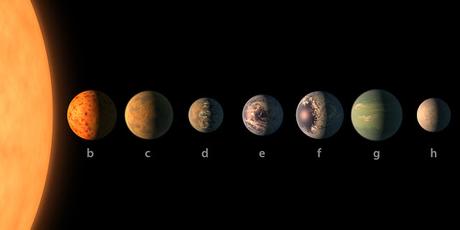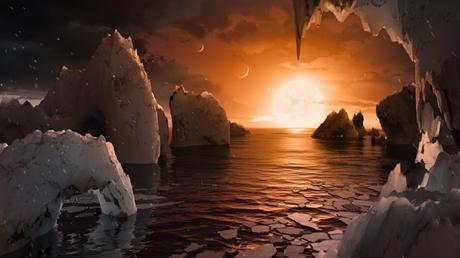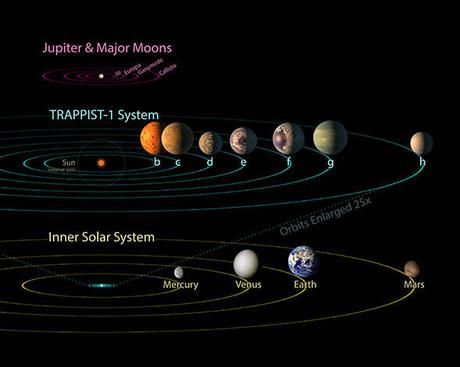 “It’s the first
time that so many planets of this kind are found around a same star,” Michaël
Gillon, the lead author of the Nature paper announcing the discovery, said in a
press conference. “The seven planets … could have some liquid water and maybe
life on the surface.” Three of the planets are directly in the star’s habitable
zone, meaning water can mostly likely exist on the surface of them. One of
them, Gillon said, has a mass “strongly to suggest a water-rich composition.”
And it’s possible that the other four could have liquid water, too, depending
on the composition of their atmospheres, the astronomers said.
To understand
further, : An exoplanet (extrasolar
planet) is a planet located outside the Solar System. The first confirmed
detection of exoplanets was announced in 1992, with two planets found orbiting
a pulsar. The first confirmation of an exoplanet orbiting a main-sequence star
was made in 1995, when a giant planet was found in a four-day orbit around the
nearby star 51 Pegasi. Some exoplanets have been imaged directly by telescopes,
but the vast majority have been detected through indirect methods such as the
transit method and the radial-velocity method. As of February 15, 2017,
astronomers have identified 3,577 such planets (in 2,687 planetary systems and
602 multiple planetary systems)
In a pathbreaking
discovery, a press release on February 22, 2017, NASA announced the discovery
of the most Earth-sized planets found in the habitable zone of a single star,
called TRAPPIST-1. This system of seven rocky worlds–all of them with the
potential for water on their surface–is an exciting discovery in the search for
life on other worlds. There is the possibility that future study of this unique
planetary system could reveal conditions suitable for life.
“It’s the first
time that so many planets of this kind are found around a same star,” Michaël
Gillon, the lead author of the Nature paper announcing the discovery, said in a
press conference. “The seven planets … could have some liquid water and maybe
life on the surface.” Three of the planets are directly in the star’s habitable
zone, meaning water can mostly likely exist on the surface of them. One of
them, Gillon said, has a mass “strongly to suggest a water-rich composition.”
And it’s possible that the other four could have liquid water, too, depending
on the composition of their atmospheres, the astronomers said.
To understand
further, : An exoplanet (extrasolar
planet) is a planet located outside the Solar System. The first confirmed
detection of exoplanets was announced in 1992, with two planets found orbiting
a pulsar. The first confirmation of an exoplanet orbiting a main-sequence star
was made in 1995, when a giant planet was found in a four-day orbit around the
nearby star 51 Pegasi. Some exoplanets have been imaged directly by telescopes,
but the vast majority have been detected through indirect methods such as the
transit method and the radial-velocity method. As of February 15, 2017,
astronomers have identified 3,577 such planets (in 2,687 planetary systems and
602 multiple planetary systems)
In a pathbreaking
discovery, a press release on February 22, 2017, NASA announced the discovery
of the most Earth-sized planets found in the habitable zone of a single star,
called TRAPPIST-1. This system of seven rocky worlds–all of them with the
potential for water on their surface–is an exciting discovery in the search for
life on other worlds. There is the possibility that future study of this unique
planetary system could reveal conditions suitable for life.
 This illustration
shows the possible surface of TRAPPIST-1f, one of the newly discovered planets
in the TRAPPIST-1 system. Scientists using the Spitzer Space Telescope and
ground-based telescopes have discovered that there are seven Earth-size planets
in the system. Credits: NASA/JPL-Caltech
NASA's Spitzer
Space Telescope has revealed the first known system of seven Earth-size planets
around a single star. Three of these planets are firmly located in the
habitable zone, the area around the parent star where a rocky planet is most
likely to have liquid water. The discovery sets a new record for greatest
number of habitable-zone planets found around a single star outside our solar
system. All of these seven planets could have liquid water – key to life as we
know it – under the right atmospheric conditions, but the chances are highest
with the three in the habitable zone.
“This discovery
could be a significant piece in the puzzle of finding habitable environments,
places that are conducive to life,” said Thomas Zurbuchen, associate
administrator of the agency’s Science Mission Directorate in Washington.
“Answering the question ‘are we alone’ is a top science priority and finding so
many planets like these for the first time in the habitable zone is a
remarkable step forward toward that goal.” At about 40 light-years (235
trillion miles) from Earth, the system of planets is relatively close to us, in
the constellation Aquarius. Because they are located outside of our solar
system, these planets are scientifically known as exoplanets.
This illustration
shows the possible surface of TRAPPIST-1f, one of the newly discovered planets
in the TRAPPIST-1 system. Scientists using the Spitzer Space Telescope and
ground-based telescopes have discovered that there are seven Earth-size planets
in the system. Credits: NASA/JPL-Caltech
NASA's Spitzer
Space Telescope has revealed the first known system of seven Earth-size planets
around a single star. Three of these planets are firmly located in the
habitable zone, the area around the parent star where a rocky planet is most
likely to have liquid water. The discovery sets a new record for greatest
number of habitable-zone planets found around a single star outside our solar
system. All of these seven planets could have liquid water – key to life as we
know it – under the right atmospheric conditions, but the chances are highest
with the three in the habitable zone.
“This discovery
could be a significant piece in the puzzle of finding habitable environments,
places that are conducive to life,” said Thomas Zurbuchen, associate
administrator of the agency’s Science Mission Directorate in Washington.
“Answering the question ‘are we alone’ is a top science priority and finding so
many planets like these for the first time in the habitable zone is a
remarkable step forward toward that goal.” At about 40 light-years (235
trillion miles) from Earth, the system of planets is relatively close to us, in
the constellation Aquarius. Because they are located outside of our solar
system, these planets are scientifically known as exoplanets.
 This exoplanet
system is called TRAPPIST-1, named for The Transiting Planets and Planetesimals
Small Telescope (TRAPPIST) in Chile. In May 2016, researchers using TRAPPIST
announced they had discovered three planets in the system. Assisted by several
ground-based telescopes, including the European Southern Observatory's Very
Large Telescope, Spitzer confirmed the existence of two of these planets and
discovered five additional ones, increasing the number of known planets in the
system to seven.
The new results
were published Wednesday in the journal Nature, and announced at a news
briefing at NASA Headquarters in Washington. Using Spitzer data, the team
precisely measured the sizes of the seven planets and developed first estimates
of the masses of six of them, allowing their density to be estimated. Based on
their densities, all of the TRAPPIST-1 planets are likely to be rocky. Further
observations will not only help determine whether they are rich in water, but
also possibly reveal whether any could have liquid water on their surfaces. The
mass of the seventh and farthest exoplanet has not yet been estimated – scientists
believe it could be an icy, "snowball-like" world, but further
observations are needed.
"The seven
wonders of TRAPPIST-1 are the first Earth-size planets that have been found
orbiting this kind of star," said Michael Gillon, lead author of the paper
and the principal investigator of the TRAPPIST exoplanet survey at the
University of Liege, Belgium. "It is also the best target yet for studying
the atmospheres of potentially habitable, Earth-size worlds."
In contrast to our
sun, the TRAPPIST-1 star – classified as an ultra-cool dwarf – is so cool that
liquid water could survive on planets orbiting very close to it, closer than is
possible on planets in our solar system. All seven of the TRAPPIST-1 planetary
orbits are closer to their host star than Mercury is to our sun. The planets
also are very close to each other. If a person was standing on one of the
planet’s surface, they could gaze up and potentially see geological features or
clouds of neighboring worlds, which would sometimes appear larger than the moon
in Earth's sky. The planets may also be tidally locked to their star, which
means the same side of the planet is always facing the star, therefore each
side is either perpetual day or night. This could mean they have weather
patterns totally unlike those on Earth, such as strong winds blowing from the
day side to the night side, and extreme temperature changes.
Spitzer, an
infrared telescope that trails Earth as it orbits the sun, was well-suited for
studying TRAPPIST-1 because the star glows brightest in infrared light, whose
wavelengths are longer than the eye can see. In the fall of 2016, Spitzer
observed TRAPPIST-1 nearly continuously for 500 hours. Spitzer is uniquely
positioned in its orbit to observe enough crossing – transits – of the planets
in front of the host star to reveal the complex architecture of the system.
Engineers optimized Spitzer’s ability to observe transiting planets during
Spitzer’s “warm mission,” which began after the spacecraft’s coolant ran out as
planned after the first five years of operations.
"This is the
most exciting result I have seen in the 14 years of Spitzer operations,"
said Sean Carey, manager of NASA's Spitzer Science Center at Caltech/IPAC in
Pasadena, California. Following up on
the Spitzer discovery, NASA's Hubble Space Telescope has initiated the
screening of four of the planets, including the three inside the habitable
zone. These observations aim at assessing the presence of puffy,
hydrogen-dominated atmospheres, typical for gaseous worlds like Neptune, around
these planets.
Very interesting
indeed !
With regards – S.
Sampathkumar
23rd Feb
2017.
This exoplanet
system is called TRAPPIST-1, named for The Transiting Planets and Planetesimals
Small Telescope (TRAPPIST) in Chile. In May 2016, researchers using TRAPPIST
announced they had discovered three planets in the system. Assisted by several
ground-based telescopes, including the European Southern Observatory's Very
Large Telescope, Spitzer confirmed the existence of two of these planets and
discovered five additional ones, increasing the number of known planets in the
system to seven.
The new results
were published Wednesday in the journal Nature, and announced at a news
briefing at NASA Headquarters in Washington. Using Spitzer data, the team
precisely measured the sizes of the seven planets and developed first estimates
of the masses of six of them, allowing their density to be estimated. Based on
their densities, all of the TRAPPIST-1 planets are likely to be rocky. Further
observations will not only help determine whether they are rich in water, but
also possibly reveal whether any could have liquid water on their surfaces. The
mass of the seventh and farthest exoplanet has not yet been estimated – scientists
believe it could be an icy, "snowball-like" world, but further
observations are needed.
"The seven
wonders of TRAPPIST-1 are the first Earth-size planets that have been found
orbiting this kind of star," said Michael Gillon, lead author of the paper
and the principal investigator of the TRAPPIST exoplanet survey at the
University of Liege, Belgium. "It is also the best target yet for studying
the atmospheres of potentially habitable, Earth-size worlds."
In contrast to our
sun, the TRAPPIST-1 star – classified as an ultra-cool dwarf – is so cool that
liquid water could survive on planets orbiting very close to it, closer than is
possible on planets in our solar system. All seven of the TRAPPIST-1 planetary
orbits are closer to their host star than Mercury is to our sun. The planets
also are very close to each other. If a person was standing on one of the
planet’s surface, they could gaze up and potentially see geological features or
clouds of neighboring worlds, which would sometimes appear larger than the moon
in Earth's sky. The planets may also be tidally locked to their star, which
means the same side of the planet is always facing the star, therefore each
side is either perpetual day or night. This could mean they have weather
patterns totally unlike those on Earth, such as strong winds blowing from the
day side to the night side, and extreme temperature changes.
Spitzer, an
infrared telescope that trails Earth as it orbits the sun, was well-suited for
studying TRAPPIST-1 because the star glows brightest in infrared light, whose
wavelengths are longer than the eye can see. In the fall of 2016, Spitzer
observed TRAPPIST-1 nearly continuously for 500 hours. Spitzer is uniquely
positioned in its orbit to observe enough crossing – transits – of the planets
in front of the host star to reveal the complex architecture of the system.
Engineers optimized Spitzer’s ability to observe transiting planets during
Spitzer’s “warm mission,” which began after the spacecraft’s coolant ran out as
planned after the first five years of operations.
"This is the
most exciting result I have seen in the 14 years of Spitzer operations,"
said Sean Carey, manager of NASA's Spitzer Science Center at Caltech/IPAC in
Pasadena, California. Following up on
the Spitzer discovery, NASA's Hubble Space Telescope has initiated the
screening of four of the planets, including the three inside the habitable
zone. These observations aim at assessing the presence of puffy,
hydrogen-dominated atmospheres, typical for gaseous worlds like Neptune, around
these planets.
Very interesting
indeed !
With regards – S.
Sampathkumar
23rd Feb
2017.
Vastly reproduced from : NASA; www.nasa.gov.

